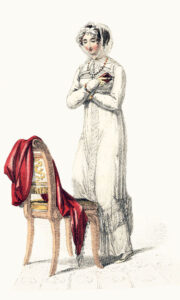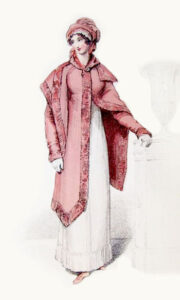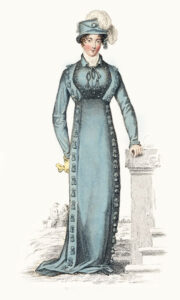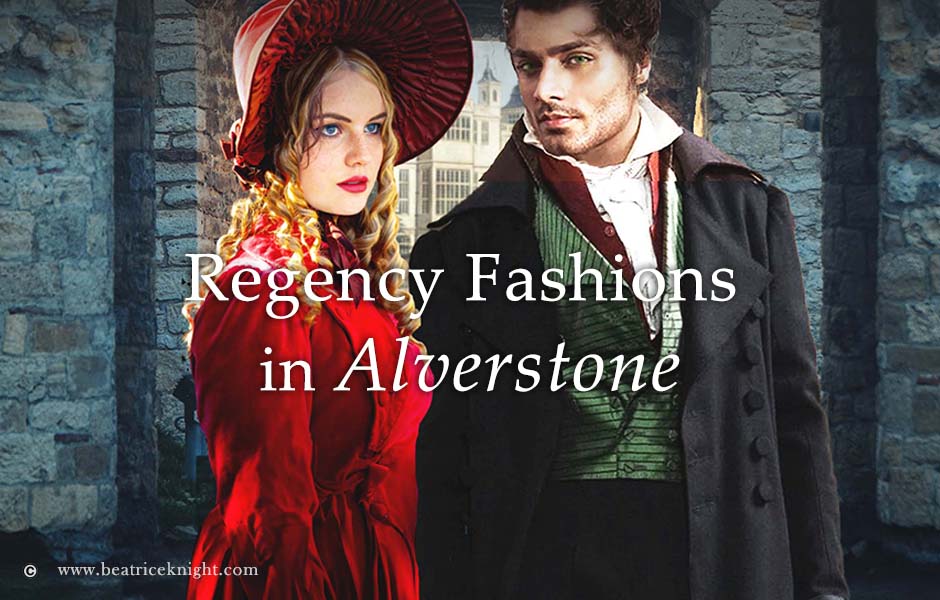
A Regency Chronicle review likens Alverstone’s detailed setting to those crafted by the incomparable Georgette Heyer. Having been inspired by her example, I’m honored by such an accolade!
Regency Fashions Showcased in Alverstone
I love historical novels that paint detailed pictures of the characters and their world. One of the guilty pleasures of writing Alverstone was being able to showcase Regency fashions and reference the modiste/dressmakers who created them.
The story is set in 1813, at a time when English fashion had reinvented itself without the Parisian influence, thanks to the ongoing war with Napoleon. The result was a distinctly English look, often eclectic and strongly influenced by pride in English heritage, military styling, and romanticism.
What Did Regency Women Wear?
Getting dressed was a full time job for upper class Regency women. Charlotte Winford is in her fifth London Season when the story opens. Like all young ladies of means, she wears multiple changes of clothes on any typical day. These could include:
- Morning Dress: also considered “Undress” was informal clothing usually worn only at home. A white or simple figured cambric or India muslin or jacanot was typical. These were generally worn over stays, a slip or shift, and a chemise. Drawers were not commonly worn until the 1820s.
- Walking / Promenade Dress: morning dress could be upgraded for wearing out in public with a spencer, pelisse, mantle or cloak. Or a woman could change into a more dressy ensemble.
- Carriage Costume: when travelling, driving out or making calls, a lovely pelisse could be worn over a walking dress or a more elaborate Afternoon Visiting Dress.
- Riding habit: usually made by a gentleman’s outfitter, ladies riding habits were more tailored and durable than most women’s apparel.
- Half dress and Half full dress: intended to be worn in the late afternoon to early evening, the look was semi-formal and could be dressed up with more elaborate jewelry and headwear as the occasion required, including as Dinner dress.
- Full dress / Evening: Very formal attire worn in the later part of the evening for social events held after dinner. Often described as Ball or Opera dress, although Half Full dress could also be worn to the theater.
- Night dress: exhausted from endless clothes changes and hair-pinning, the young Regency lady would fall into bed in the small hours wearing either a shapeless cotton shift or chemise, which doubled as undergarments during the day. In cooler weather or for more modesty, women wore a loose Bed Jacket or Fichu over their shift. Those whose budgets ran to purpose made sleepwear, might wear a longer high-necked Nightrail.
Viewers of Bridgerton saw a “bonnet-free world,” a decision of the showrunner who wanted to capture the Regency vibe, but with a twist. Costume designer Ellen Mirojnick described the look as: “…the opposite of Jane Austen, as the costumes needed to have an aspirational layer.”
For women who actually lived in 1813, no ensemble was complete without headwear and accessories. These varied in formality, but in 1813 the strongest fashion influence was the war. Almost any hat or cloak could claim some military inspiration, and most did. Flipping through Ackermann’s Repository or La Belle Assemblée, one encounters a Vittorean cloak or Pyrennean mantle (see Walking dress below), a cap à la Russe and a Kutusoff hat, spencers ornamented a la militaire, Cossack coats, Russian tippets, and of course all things Wellington.
A Young Lady’s Wardrobe in 1813
Alverstone follows Charlotte Winford’s story from July to December of 1813 – the same year in which Bridgerton’s first Season is set. Genteel young ladies would have dressed in outfits like these:
Charlotte wore several of the outfits shown. At the Reynolds Exhibition with Lord Alverstone, she worries that she has gone overboard with her Pomeranian mantle and lace flounces (the Promenade Dress top row above).
Riding with Lord Alverstone in Hyde Park, she wore the Batavia styled riding costume described (La Belle Assemblée, August 1812) as: “Made of ladies habit cloth… trimmed down each side of the front with Spanish buttons. The collar is… fashioned negligently at the throat with a large cord and tassel; it opens sufficiently to display the shirt, which is of lace in general…”
Charlotte’s version is crimson, not blue, and:
“Having expected to be alone, she had not bothered to tighten the tassel cords at her throat, and as she straightened her shoulders, the Spanish buttons popped apart from her collar to her chest. A waterfall of lace spilled out….”
Flirtatious Fashions in Vauxhall Gardens
After Lord Wellington’s great victory in the Battle of Vitoria, London celebrates with a grand fete at Vauxhall Gardens. Naturally Charlotte must have a new gown and orders the latest style from a leading modiste of the day, Mrs. Bean. Fashions seen in the pleasure gardens of London and Paris were a far cry from drawing room attire. Usually the slightly less formal ‘Half dress’ attire was worn, but for major events like the Vitoria Fête, Full dress was expected. Charlotte wore the gown below, which appeared in Ackermann’s Repository.
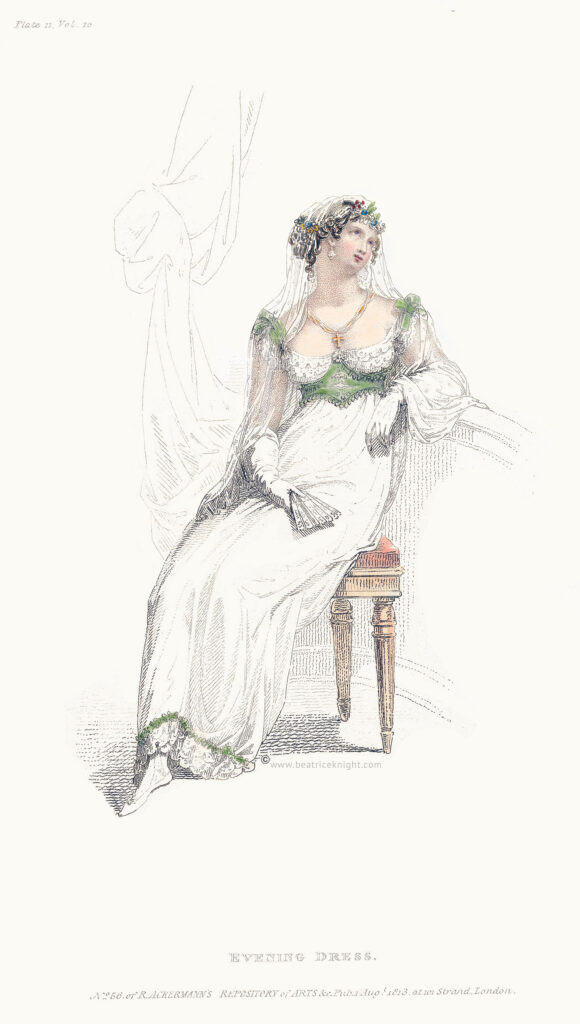
Vitoria Fête Dress. Ackermann’s Repository. August, 1813. Restored and recolored by Beatrice Knight.
“… No one expected a young lady of Charlotte’s age to dress as a rustic ingenue, but the gown her aunt lifted from its wrapping could have been designed for a house of ill fame.
“Vauxhall modes are scanty,” said her aunt. “But good heavens. Qui ne cache rien!”
Charlotte had been amused when Mrs. Bean said the Circassian bodice, which buttoned high below the bosom, would display her small breasts like plump little doves. Inspecting the shockingly low neckline, she realized the modiste was not jesting. Almost as concerning was the skirt. Although it was weighted beneath a delicate pattern of laurel leaves, the thin Venetian crepe would cling with every movement. Deep scallops lifted the hem, secured by clusters of imitation pearls. Her ankles would be brazenly on display.
“If I wished to look like an opera dancer, this would be ideal.” Charlotte sighed. “Perhaps I should wear something else.”
“Do not be provincial, dear. Only the most superior habiliments will suffice for the fête, and you have nothing else so au courant as Mrs. Bean’s confection.” Her aunt rustled through her closet and produced a Russian mantle. “I know young ladies think it a crime to cover themselves, but this would flatter you. It is the same Pomona green as the bodice.” …
A Rich Widow
Charlotte’s chaperone for the London Season is Aunt Stirling, her mother’s widowed older sister. Wealthy and childless, Aunt Stirling takes an avid interest in fashion and has a predilection for pink. When her sister, Lady Winford arrives in town, Aunt Stirling takes the family shopping and offers guidance on the latest trends:
“…Aunt Stirling, who lived by the edicts of La Belle Assemblée, shook her head in dismay. “Feathers are du vieux temps for walking dress this Season, Margaret, and barely seen west of Soho Square. Flowers, that is the thing for any woman not in doddering decline.”
“Are not flowers rather ingénue when one has grown daughters?” Lady Winford glanced uneasily at a plump matron approaching the next counter.
Although well beyond her meridian, she wore a satin straw hat weighed down with hyacinth and roses and tied under her heavy chin with a Barcelona handkerchief. Her pink-striped sarsnet walking dress boasted an Elizabethan ruff and slashed puff sleeves down to her wrists. Rows of stiff Vandyke lace encircled the hem. Her jonquille gloves and parasol lent a jaunty touch, which she must have thought insufficient, for she also sported gigantic shoulder knots in the same hue.
“Butter on bacon, to be sure,” murmured Aunt Stirling… “
Shopping for Clothes at Harding Howell
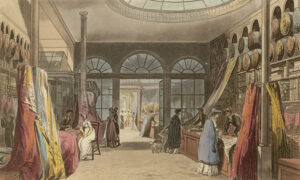
Harding Howell. Ackermann’s Repository. April, 1809
When Sylvie Winford, an orphaned ‘poor relation,’ arrives from America with her maid Eulalia, a former slave, the Winford ladies descend on Harding Howell to equip the new arrivals respectably.
Situated in Schomberg House at 89 Pall Mall, the store was the Regency equivalent of a department store. A destination for well heeled women, Ackermann’s Repository described it as: “…fitted up with great taste and [it is] divided by glazed partitions into four departments…” namely furs and fans; haberdashery; jewelry; and millinery and dresses. 150 feet in length, the store employed forty staff and ordered from an army of artisan suppliers. “There is scarcely a manufacturing town in the kingdom but what it is laid under contribution by this establishment…” noted Ackermann’s.
Pulling up outside the lofty building, Sylvie:
“… peered up in awe at the tall arched windows and classical façade. “Harding, Howell, Ashby, and James,” she read the sign above the door. “It’s fearfully grand for a store.”
“There will never be anything like it in the colonies,” said Lady Winford. “Such mullions. Conceive of the window tax.”
They are greeted by:
“…a linendraper who favored the look of a previous century, disporting himself in figured silk and velvet. A profusion of ruffles spilled from each sleeve. His obsequious bow was only slightly less dramatic than his peruke.”
Miss Thorne’s Villainy Extends to her Taste in Fashion
Not content with her fortune of eighty thousand pounds, the disagreeable Miss Angelica Thorne also wants to be the Marchioness of Alverstone. She and Jasper Alverstone loathe one another, but when did personal animosity stand in the way of a brilliant match? Miss Thorne has been on the Continent for the past two years, as her clothing suggests:
“… Her dress looked foreign—a voluminous purple satin Saxe-Coburg robe over a white slip slathered in ribbons and lace. The train was unfashionably long even for full dress, and a matron twice her age would have hesitated to flaunt such lavish tippets of ermine….
___
“…a woman rounded the corner of Bruton Street, looking for all the world like an exotic wasp, in a yellow and tan striped walking dress with a tiger-fur tippet slung carelessly over one shoulder, its tassels the size of tree lanterns. Black feathers waved like antennae atop a modish tan helmet, and a wig-row of unnaturally fair curls haloed the strange headwear.
Each step she took was punctuated by the swing of a gold-topped walking cane as tall as her shoulders. A turbaned Indian page in colorful silks high-stepped behind her, holding a precariously tall dome-like parasol above her head.
“Good God,” said his lordship, and instantly begged their pardon.
“Miss Thorne is not to be ignored.” Aunt Stirling lifted her eyeglass for a closer inspection. “Queue de singe. Not the kindest color for a female whose skin has seen too much Italian sun.” “
___
“She has been on the Continent these past few years,” said Charlotte, “which explains her pelisse.”
“Feuille morte satin. And swan’s-down trim. In July! Such taste should be treasonable.”
___
Read More
La Belle Assemblée. J. Bell. London
The Lady’s Magazine. G. Robinson. London
The Lady’s Monthly Museum. Vernor, Hood, and Sharpe. London
The Repository of Arts, Literature, Commerce, Manufactures, Fashions and Politics. R. Ackermann. London
Knight, Beatrice. Alverstone. Maiden Press, 2023.
Laudermilk, Sharon and Hamlin, Teresa L.. The Regency Companion. Garland, 1989.

